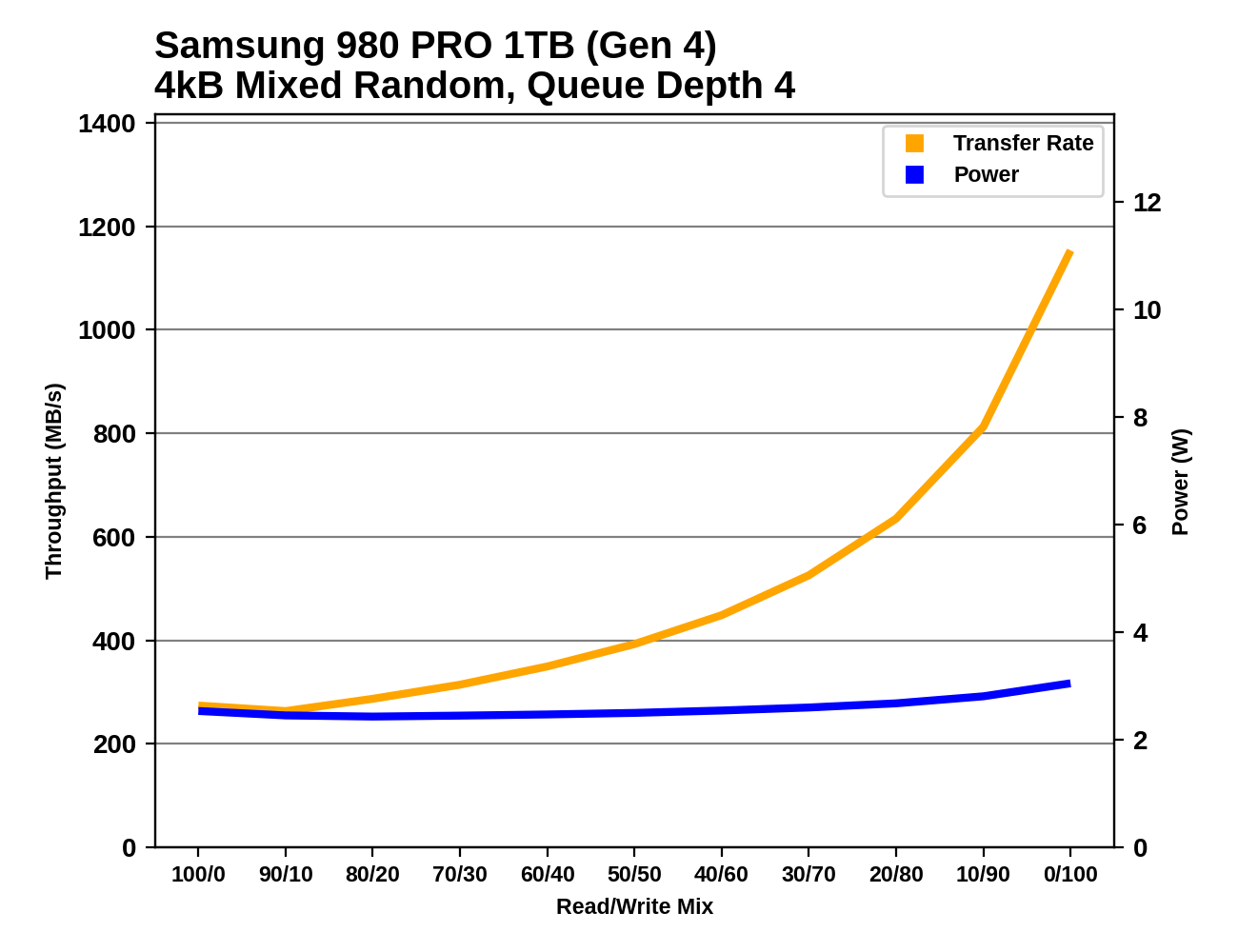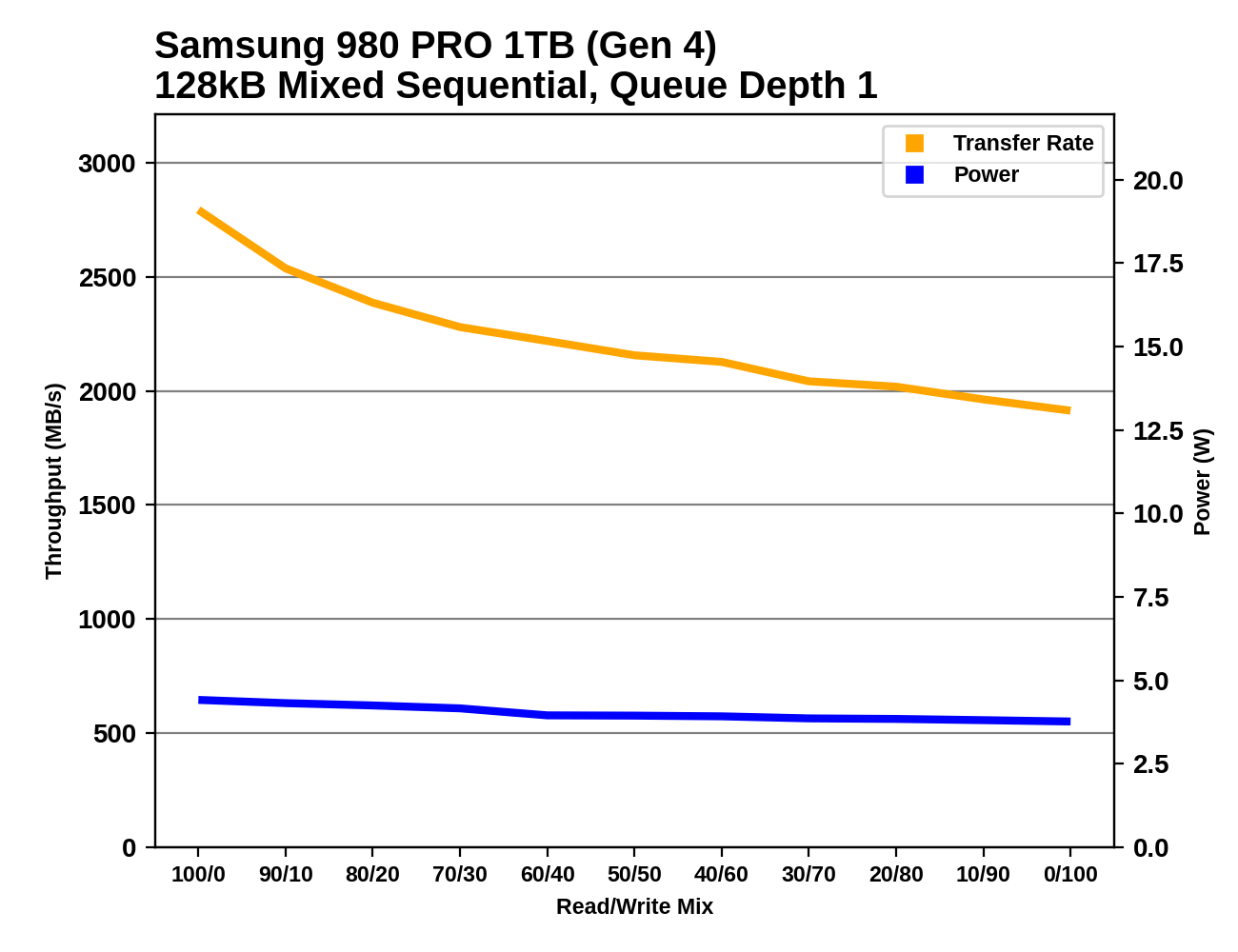The Samsung 980 PRO PCIe 4.0 SSD Review: A Spirit of Hope
by Billy Tallis on September 22, 2020 11:20 AM ESTNote: All our previous testing has been on an Intel test bed. Because of the move to PCIe 4.0, we have upgraded to Ryzen. Devices tested under Ryzen in time for this review are identified in the charts.
Mixed Random Performance
Our test of mixed random reads and writes covers mixes varying from pure reads to pure writes at 10% increments. Each mix is tested for up to 1 minute or 32GB of data transferred. The test is conducted with a queue depth of 4, and is limited to a 64GB span of the drive. In between each mix, the drive is given idle time of up to one minute so that the overall duty cycle is 50%.

Since our mixed random IO test uses a moderate queue depth of 4, the PCIe Gen4 drives don't get much chance to flex their muscle. The overall scores are still generally bound by NAND flash latency, which doesn't vary too widely between current generation drives. There's also a small performance boost when running this test on our newer, faster Ryzen testbed. The Samsung 980 PRO is clearly an improvement over its predecessors, but is merely tied for first place among flash-based drives with the SK hynix Gold P31.
 |
|||||||||
| Power Efficiency in MB/s/W | Average Power in W | ||||||||
Both capacities of the 980 PRO turn in good efficiency scores for the mixed random IO test, substantially improving on Samsung's previously mediocre standing. The 1TB 980 PRO's efficiency is second only to the SK hynix Gold P31. The 980 PROs are a bit more efficient running at PCIe Gen3 speeds than on the Gen4 platform, despite the ~10% performance boost on the faster system.
 |
|||||||||
There are no real surprises in the performance profiles of the 980 PROs. Both capacities show the same general behavior as earlier Samsung drives, albeit with small improvements to performance and power consumption across the board.
Mixed Sequential Performance
Our test of mixed sequential reads and writes differs from the mixed random I/O test by performing 128kB sequential accesses rather than 4kB accesses at random locations, and the sequential test is conducted at queue depth 1. The range of mixes tested is the same, and the timing and limits on data transfers are also the same as above.

The Samsung 980 PROs take the top spots for our mixed sequential IO test, with even the 250GB 980 PRO edging out the 1TB Seagate FireCuda 520. Even when limited to PCIe Gen3, the 980s are a clear step up in performance from eariler high-end drives. The improvement for the 250GB model is the most impressive, since the 250GB 970 EVO Plus is significantly slower than most of the 1TB drives.
 |
|||||||||
| Power Efficiency in MB/s/W | Average Power in W | ||||||||
The 980 PROs turn in more good power efficiency numbers that place them clearly ahead of everything other than the SK hynix Gold P31. And this time, the P31's efficiency lead relatively small at no more than about 25%.
 |
|||||||||
The 980 PROs show a drastically different performance profile compared to earlier Samsung drives. The 970s tend to bottom out during the write-heavy half of the test and recover some performance toward the end. Now with the 980 PRO, performance in the write-heavy half doesn't drop precipitously, so we see a steady decline that most closely resembles how the Intel Optane SSD handles this test










137 Comments
View All Comments
5j3rul3 - Wednesday, September 23, 2020 - link
980 Pro (X)980 EVO (O)
DarkMatter69 - Wednesday, September 23, 2020 - link
Could the comparison include some of the fastest M.2 SSDs already in market, e.g. Sabrent Rocket 4, Corsair MP600, Aorus NVM, etc.? the comparison drives used in this article are not the fastest ones, so it is difficult to understand how good is this M.2 drive vs all the other top ones in the market already. Thank you!Slash3 - Wednesday, September 23, 2020 - link
I'd also like to see a few more models make their way through the Anandtech tests, but the Seagate Firecuda 520 in this review is essentially representative of the models you listed. They're all based on what are effectively reference Phison E16 designs and can even be cross-flashed with the same firmware. Upcoming Phison E18 based drives should shake things up a little bit more and will be the true point of comparison for the 980 Pro.Koenig168 - Wednesday, September 23, 2020 - link
980 Evo masquerading as 980 Pro.yetanotherhuman - Wednesday, September 23, 2020 - link
TLC != Pro. Forget it. 2-bit or bust.twtech - Wednesday, September 23, 2020 - link
The write endurance on this drive is identical to the 970 EVO. Yeah, it may be a bit faster - especially being PCIE 4.0 - but it's not like you can use it in ways that you can't use the (much cheaper) non-Pro drives now.Whiteknight2020 - Wednesday, September 23, 2020 - link
And you are entirely missing the point. "Pro" is a generic, meaningless, marketing term. Just look on Amazon for "pro" branded items, ranging from cheap tat to quality (for specific use cases) items. You are choosing to interpret the way a marketing/branding term has previously been applied to product by a manufacturer as having a fixed value and meaning which it does not, it is merely branding and ascribes no specific technical, functional or physical properties to the product. That you are entitled to be aggrieved at the way the branding is used is not in question, what is is your giving the branding a meaning which it does not have.XabanakFanatik - Wednesday, September 23, 2020 - link
Pro is not a generic, meaningless marketing term. Pro is a branding on Samsung SSD's that Samsung has been cultivating for a decade, which has a very well-defined meaning. Samsung Pro SSD's are 2-bit MLC with sustained write performance and high endurance.This drive has none of the three things that has defined a Samsung Pro SSD for a decade.
They just threw a decade of brand building away with one product.
edzieba - Wednesday, September 23, 2020 - link
The near-zero change in random performance at QD1 for PCIe 3 vs. 4 was expected, but the very lot bump in high-QD sequential transfers was not. It's abundantly clear that PCIe 4 bandwidth, at least for desktop use, has no practical applications as of yet.lightningz71 - Wednesday, September 23, 2020 - link
I wonder how the lower end NVME drives will fare when they move to PCIe 4.0? One of the hangups of using host drive map caching was the slower data path between the drive controller and the host memory that was imposed by having to cross the PCIe 3.0 lanes to get to the host memory. Eventually, cacheless controllers will move to PCIe 4.0. Will it be cheaper to make a cacheless PCIe 4.0 controller that actually uses all 4 lanes (some of the cheapest PCIe 3.0 cacheless controllers only used 2 lanes) than to stay with a more mature PCIe 3.0 controller that has a modest amount of cache with it? Will the performance be close enough to make that decision moot?